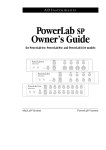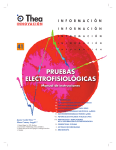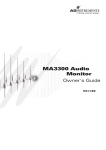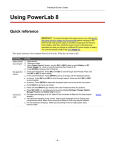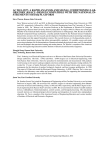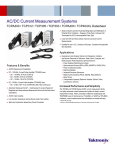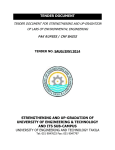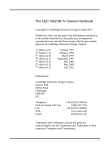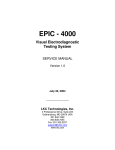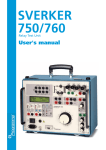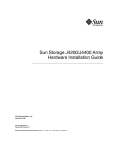Download Bio Amp Owner`s Guide
Transcript
Bio Amp Owner’s Guide This document was, as far as possible, accurate at the time of release. However, changes may have been made to the software and hardware it describes since then. ADInstruments Pty Ltd reserves the right to alter specifications as required. Latebreaking information may be supplied separately. Trademarks of ADInstruments PowerLab®, LabChart®, LabTutor®, LabAuthor® and MacLab® are registered trademarks of ADInstruments Pty Ltd. The names of specific recording units, such as PowerLab 8/30, are trademarks of ADInstruments Pty Ltd. LabTutor Server, Chart and Scope (application programs) and LabTutor Online are trademarks of ADInstruments Pty Ltd. Other Trademarks Apple, Mac and Macintosh are registered trademarks of Apple Computer, Inc. Windows, Windows 7, Windows Vista and Windows XP are either registered trademarks or trademarks of Microsoft Corporation. All other trademarks are the property of their respective owners. Product: ML132 Bio Amp; ML135 Dual Bio Amp; ML138 Octal Bio Amp Document Number: U-ML132-OG-004C Part Number: 4377 Copyright © December 2009 ADInstruments Pty Ltd. Unit 13, 22 Lexington Drive, Bella Vista, NSW 2153, Australia All rights reserved. No part of this document may be reproduced by any means without the prior written permission of ADInstruments Pty Ltd. Web: www.adinstruments.com Technical Support: [email protected] Documentation: [email protected] ADInstruments Pty Ltd. ISO 9001:2000 Certified Quality Management System Reg. No. 1053 ii Bio Amp Owner’s Guide Contents Safety Notes 5 1 Overview How to Use This Guide . . . . . . . . Checking the Front-end . . . . . Front-end Fundamentals . . . . . The Front-end . . . . . . . . . . . . . The Front Panel . . . . . . . . . . The Input Socket . . . . . . . The Status Indicator . . . . . Audio Out Socket . . . . . . . The Back Panel . . . . . . . . . . I2C Input and Output Sockets Analog Output Sockets . . . . Audio Out Socket . . . . . . . The Bio Amp Cable . . . . . . . . . . Types of Measurement . . . . . . . . Recording Technique . . . . . . . . . 11 . . . . . . . . . . . . . . . . . . . . . . . . . . . . . . . . . . . . . . . . . . . . . . . . . . . . . . . . . . . . . . . . . . . . . . . . . . . . . . . . . . . . . . . . . . . . . . . . . . . . . . . . . . . . . . . . . . . . . . . . . . . . . . . . . . . . . . . . . . . . . . . . . . . . . . . . . . . . . . . . . . . . . . . . . . . . . . . . . . . . . . . . . . . . . . . . . . . . . . . . . . . . . . . . . . . . . . . . . . . . . . . . . . . . . . . . . . . . . . . . . . . . . . . . . . . . . . . . . . . . . . . . . . . . . . . . . . . . . . . . . . . . . . . . . . . . . . . . . . . . . . . . . . . . . . . . . . . . . . . . . . . . . . . . . . . . . . . . . . . . . . . . . . . . . . . . . . . . . . . . . . . . . . . . . . . . . . . . . . . . . . . . . . . . . . . . . . . . . . . . . . . . . 2 Setting Up Connecting to the PowerLab . . . . . . . Using More Than One Bio Amp Using ADInstruments Programs . . . . . The Front-end Driver . . . . . . . The Bio Amp Self-test . . . . . . Software Behavior . . . . . . . . . The Bio Amp . . . . . . . . . . . . . . . . Signal Display . . . . . . . . . . . Setting the Range . . . . . . . . . Filtering . . . . . . . . . . . . . . EEG Mode . . . . . . . . . . . . . Inverting the Signal . . . . . . . . Units . . . . . . . . . . . . . . . . DC Restore . . . . . . . . . . . . Contents . . . . . . . . . . . . . . . 12 12 12 13 13 13 14 15 15 15 15 15 16 17 18 21 . . . . . . . . . . . . . . . . . . . . . . . . . . . . . . . . . . . . . . . . . . . . . . . . . . . . . . . . . . . . . . . . . . . . . . . . . . . . . . . . . . . . . . . . . . . . . . . . . . . . . . . . . . . . . . . . . . . . . . . . . . . . . . . . . . . . . . . . . . . . . . . . . . . . . . . . . . . . . . . . . . . . . . . . . . . . . . . . . . . . . . . . . . . . . . . . . . . . . . . . . . . . . . . . . . . . . . . . . . . . . . . . . . . . . . . . . . . . . . . . . . . . . . . . . . . . . . . . . . . . . . . . . . . . . . . . . . . . . . . . . . . . . . . . . . . . . . . . . . . . . . . . . . . . . . . . . . . . . . . . . . . . . . . . . . . . . . . . . . . . . . . . . . . . . . . . . . . . . . . . . . . . 22 23 23 24 24 24 25 25 26 26 28 28 28 28 iii A Technical Aspects 29 Bio Amp Operation. . . . . . . . . . . . . . . . . . . . . . . . . . . . . . . . . . . . . . . 32 Technical Description . . . . . . . . . . . . . . . . . . . . . . . . . . . . . . . . . . . . . 32 The Bio Amp Cable Input . . . . . . . . . . . . . . . . . . . . . . . . . . . . . . . . . . . 33 B Troubleshooting 35 Problems and Solutions . . . . . . . . . . . . . . . . . . . . . . . . . . . . . . . . . . . . 36 C Specifications Single Bio Amp . . . . . . . . . Input . . . . . . . . . . . . . Filtering . . . . . . . . . . . Output . . . . . . . . . . . . Control Port . . . . . . . . Physical Configuration . . Safety . . . . . . . . . . . . Dual Bio Amp . . . . . . . . . Input . . . . . . . . . . . . . Filtering . . . . . . . . . . . Output . . . . . . . . . . . . Control Port . . . . . . . . Physical Configuration . . Safety . . . . . . . . . . . . Octal Bio Amp . . . . . . . . . Input . . . . . . . . . . . . . Filtering . . . . . . . . . . . Output . . . . . . . . . . . . Control Port . . . . . . . . Physical Configuration . . Safety . . . . . . . . . . . . Electromagnetic Compatibility Emmisions . . . . . . . . . Immunity . . . . . . . . . . Separation Distances . . . . Index iv 39 . . . . . . . . . . . . . . . . . . . . . . . . . . . . . . . . . . . . . . . . . . . . . . . . . . . . . . . . . . . . . . . . . . . . . . . . . . . . . . . . . . . . . . . . . . . . . . . . . . . . . . . . . . . . . . . . . . . . . . . . . . . . . . . . . . . . . . . . . . . . . . . . . . . . . . . . . . . . . . . . . . . . . . . . . . . . . . . . . . . . . . . . . . . . . . . . . . . . . . . . . . . . . . . . . . . . . . . . . . . . . . . . . . . . . . . . . . . . . . . . . . . . . . . . . . . . . . . . . . . . . . . . . . . . . . . . . . . . . . . . . . . . . . . . . . . . . . . . . . . . . . . . . . . . . . . . . . . . . . . . . . . . . . . . . . . . . . . . . . . . . . . . . . . . . . . . . . . . . . . . . . . . . . . . . . . . . . . . . . . . . . . . . . . . . . . . . . . . . . . . . . . . . . . . . . . . . . . . . . . . . . . . . . . . . . . . . . . . . . . . . . . . . . . . . . . . . . . . . . . . . . . . . . . . . . . . . . . . . . . . . . . . . . . . . . . . . . . . . . . . . . . . . . . . . . . . . . . . . . . . . . . . . . . . . . . . . . . . . . . . . . . . . . . . . . . . . . . . . . . . . . . . . . . . . . . . . . . . . . . . . . . . . . . . . . . . . . . . . . . . . . . . . . . . . . . . . . . . . . . . . . . . . . . . . . . . . . . . . . . . . . . . . . . . . . . . . . . . . . . . . . . . . . . . . . . . . . . . . . . . . . . . . . . . . . . . . . . . . . . . . . . . . . . . . . . . . . . . . . . . . . . . . . 39 . 39 . 40 . 40 . 40 . 40 . 41 . 41 . 41 . 42 . 43 . 43 . 43 . 43 . 43 . 43 . 45 . 45 . 45 . 45 . 45 . 47 . 47 . 47 . 47 49 Bio Amp Owner’s Guide Safety Notes Statement of Intended Use All products manufactured by ADInstruments are intended for use in teaching and research applications and environments only. ADInstruments products are NOT intended to be used as medical devices or in medical environments. That is, no product supplied by ADInstruments is intended to be used to diagnose, treat or monitor a subject. Furthermore no product is intended for the prevention, curing or alleviation of disease, injury or handicap. Where a product meets IEC 60601-1 it is under the principle that: • it is a more rigorous standard than other standards that could be chosen, and • it provides a high safety level for subjects and operators. The choice to meet IEC 60601-1 is in no way to be interpreted to mean that a product: • is a medical device, • may be interpreted as a medical device, or • is safe to be used as a medical device. Safety Symbols Devices manufactured by ADInstruments that are designed for direct connection to humans are tested to IEC 601-1:1998 (including amendments 1 and 2) and 60601-1-2, and carry one or more of the safety symbols below. These symbols appear next to those inputs and output connectors that can be directly connected to human subjects. Safety Notes 5 ! BF symbol: Bodyprotected equipment CF symbol: Cardiacprotected equipment Warning symbol: ‘see documentation’ The three symbols are: • • • BF (body protected) symbol. This means that the input connectors are suitable for connection to humans provided there is no direct electrical connection to the heart. CF (cardiac protected) symbol. This means that the input connectors are suitable for connection to human subjects even when there is direct electrical connection to the heart. Warning symbol. The exclamation mark inside a triangle means that the supplied documentation must be consulted for operating, cautionary or safety information before using the device. Further information is available on request. Bio Amp Safety Instructions The Bio Amp inputs displaying any of the safety symbols are electrically isolated from the mains supply in order to prevent current flow that may otherwise result in injury to the subject. Several points must be observed for safe operation of the Bio Amp: • • • 6 All Bio Amp front-ends (except for the ML138 Octal Bio Amp) and PowerLab units with a built-in Bio Amp are supplied with a 3-lead or 5lead Bio Amp subject cable and lead wire system. The ML138 Octal Bio Amp is supplied with unshielded lead wires (1.8 m). Bio Amps are only safe for human connection if used with the supplied subject cable and lead wires. All Bio Amp front-ends and PowerLab units with a built-in Bio Amp are not defibrillator-protected. Using the Bio Amp to record signals during defibrillator discharges may damage the input stages of the amplifiers. This may result in a safety hazard. Never use damaged Bio Amp cables or leads. Damaged cables and leads must always be replaced before any connection to humans is made. Bio Amp Owner’s Guide Isolated Stimulator Safety Instructions The Isolated Stimulator outputs of a front-end signal conditioner or PowerLab with a built-in isolated stimulator are electrically isolated. However, they can produce pulses of up to 100 V at up to 20 mA. Injury can still occur from careless use of these devices. Several points must be observed for safe operation of the Isolated Stimulator: • • • • • • • • • • The Isolated Stimulator output must only be used with the supplied bar stimulus electrode. The Isolated Stimulator output must not be used with individual (physically separate) stimulating electrodes. Stimulation must not be applied across the chest or head. Do not hold one electrode in each hand. Always use a suitable electrode cream or gel and proper skin preparation to ensure a low-impedance electrode contact. Using electrodes without electrode cream can result in burns to the skin or discomfort for the subject. Subjects with implantable or external cardiac pacemakers, a cardiac condition, or a history of epileptic episodes must not be subject to electrical stimulation. Always commence stimulation at the lowest current setting and slowly increase the current. Stop stimulation if the subject experiences pain or discomfort. Do not use faulty cables, or those that have exhibited intermittent faults. Do not attempt to measure or record the Isolated Stimulator waveform while connected to a subject using a PowerLab input or any other piece of equipment that does not carry the appropriate safety symbol (see Safety Symbols above). Always check the status indicator on the front panel. It will always flash green each time the stimulator delivers a current pulse. A yellow flash indicates an ‘out-of-compliance’ (OOC) condition that may be due to the electrode contact drying up. Always ensure that there is good electrode contact at all times. Electrodes that are left on a subject for some time need to be checked for dry contacts. An electrode impedance meter can be used for this task. • Safety Notes Always be alert for any adverse physiological effects in the subject. At the first sign of a problem, stimulation must be stopped, either from the software or by flicking down the safety switch on the front panel of any built-in Isolated Stimulator or the ML180 Stimulus Isolator. 7 • The ML180 Stimulus Isolator is supplied with a special transformer plug pack. The plug pack complies with medical safety requirements. Therefore, under no circumstances should any other transformer be used with the Stimulus Isolator. For a replacement transformer plug pack please contact your nearest ADInstruments representative. General Safety Instructions To achieve the optimal degree of subject and operator safety, consideration should be given to the following guidelines when setting up a PowerLab system either as stand-alone equipment or when using PowerLab equipment in conjunction with other equipment. Failure to do so may compromise the inherent safety measures designed into PowerLab equipment. The following guidelines are based on principles outlined in the international safety standard IEC60601-1-1: General requirements for safety - Collateral standard: Safety requirements for medical systems. Reference to this standard is required when setting up a system for human connection. PowerLab systems (and many other devices) require the connection of a personal computer for operation. This personal computer should be certified as complying with IEC60950 and should be located outside a 1.8 m radius from the subject (so that the subject cannot touch it while connected to the system). Within this 1.8 m radius, only equipment complying with IEC606011 should be present. Connecting a system in this way obviates the provision of additional safety measures and the measurement of leakage currents. Accompanying documents for each piece of equipment in the system should be thoroughly examined prior to connection of the system. While it is not possible to cover all arrangements of equipment in a system, some general guidelines for safe use of the equipment are presented below: • • • • • 8 Any electrical equipment which is located within the SUBJECT AREA should be approved to IEC60601-1. Only connect those parts of equipment that are marked as an APPLIED PART to the subject. APPLIED PARTS may be recognized by the BF or CF symbols which appear in the Safety Symbols section of these Safety Notes. Only CF-rated APPLIED PARTS must be used for direct cardiac connection. Never connect parts which are marked as an APPLIED PART to those which are not marked as APPLIED PARTS. Do not touch the subject to which the PowerLab (or its peripherals) is connected at the same time as making contact with parts of the PowerLab Bio Amp Owner’s Guide • • • • • (or its peripherals) that are not intended for contact to the subject. Cleaning and sterilization of equipment should be performed in accordance with manufacturer’s instructions. The isolation barrier may be compromised if manufacturer’s cleaning instructions are not followed. The ambient environment (such as the temperature and relative humidity) of the system should be kept within the manufacturer’s specified range or the isolation barrier may be compromised. The entry of liquids into equipment may also compromise the isolation barrier. If spillage occurs, the manufacturer of the affected equipment should be contacted before using the equipment. Many electrical systems (particularly those in metal enclosures) depend upon the presence of a protective earth for electrical safety. This is generally provided from the power outlet through a power cord, but may also be supplied as a dedicated safety earth conductor. Power cords should never be modified so as to remove the earth connection. The integrity of the protective earth connection between each piece of equipment and the protective earth should be verified regularly by qualified personnel. Avoid using multiple portable socket-outlets (such as power boards) where possible as they provide an inherently less safe environment with respect to electrical hazards. Individual connection of each piece of equipment to fixed mains socket-outlets is the preferred means of connection. If multiple portable socket outlets are used, they are subject to the following constraints: • • • They shall not be placed on the floor. Additional multiple portable socket outlets or extension cords shall not be connected to the system. They shall only be used for supplying power to equipment which is intended to form part of the system. Cleaning and Sterilization ADInstruments products may be wiped down with a lint free cloth moistened with industrial methylated spirit. Refer to the manufacturer’s guidelines or the Data Card supplied with transducers and accessories for specific cleaning and sterilizing instructions. Safety Notes 9 Preventative Inspection and Maintenance PowerLab systems and ADInstruments front-ends are all maintenance-free and do not require periodic calibration or adjustment to ensure safe operation. Internal diagnostic software performs system checks during power up and will report errors if a significant problem is found. There is no need to open the instrument for inspection or maintenance, and doing so within the warranty period will void the warranty. Your PowerLab system can be periodically checked for basic safety by using an appropriate safety testing device. Tests such as earth leakage, earth bond, insulation resistance, subject leakage and auxiliary currents and power cable integrity can all be performed on the PowerLab system without having to remove the covers. Follow the instructions for the testing device if performing such tests. If the PowerLab system is found not to comply with such testing you should contact your PowerLab representative to arrange for the equipment to be checked and serviced. Do not attempt to service the device yourself. Environment Electronic components are susceptible to corrosive substances and atmospheres, and must be kept away from laboratory chemicals. Storage Conditions • • Temperature in the range 0–40 °C Non-condensing humidity in the range 0–95%. Operating Conditions • • Temperature in the range 5–35 °C Non-condensing humidity in the range 0–90%. Disposal • 10 Forward to recycling center or return to manufacturer. Bio Amp Owner’s Guide Overview 1 The Bio Amp is a modular device, in a family called front-ends, designed to extend the capabilities of the PowerLab© system. The Bio Amp allows the PowerLab system to record biological signals, such as ECGs (EKGs), EMGs, and EEGs, from humans or animals, with full electrical isolation. This chapter provides an overview of the Bio Amp, Dual Bio Amp and Octal Bio Amp, describing their basic features and the measurement of signals. Chapter 1 Overview 11 How to Use This Guide This owner’s guide describes how to set up and begin using your Bio Amp. The chapters give an overview of front-ends in general and the Bio Amp in particular, and discuss how to connect the hardware, perform a simple powerup test, and use the Bio Amp with some ADInstruments programs. The appendices provide technical information about the Bio Amp, and take a look at some potential problems and their solutions. There is an index at the end of this guide. Technical terms that are not defined in the glossary of terms included with the owner’s guide for your PowerLab, or in the guide that came with your computer, are defined as they appear. Checking the Front-end Before connecting the Bio Amp to anything, check it carefully for signs of physical damage. 1. Check that there are no obvious signs of damage to the outside of the front-end casing. 2. Check that there is no obvious sign of internal damage, such as rattling. Pick up the front-end, tilt it gently from side to side, and listen for anything that appears to be loose. If you have found a problem, contact your authorized ADInstruments representative immediately, and describe the problem. Front-end Fundamentals The PowerLab system consists of a recording unit and application programs that run on the computer to which the unit is connected. It is an integrated system of hardware and software designed to record, display, and analyze experimental data. The Bio Amp is one of a family of front-ends meant for use with your PowerLab system. Front-ends are ancillary devices connected to the PowerLab recording unit to extend the system’s capabilities. They provide additional signal conditioning and other features, and extend the types of experiments that you can conduct and the data you can record. All ADInstruments front-ends are designed to be operated under full software control. No knobs, dials, or switches are needed, although some may be provided for reasons of convenience or safety. 12 Bio Amp Owner’s Guide The PowerLab controls front-ends through an expansion connector called the I2C (pronounced ‘eye-squared-sea’) bus. Each front-end added to the system connects to the back of the previous front-end, in a simple daisy-chain structure. This makes it easy to add front-ends to the system or to transfer them between PowerLabs. In general, each front-end requires at least one analog input channel of the PowerLab. Front-ends are automatically recognized by the PowerLab system. Any frontend feature such as gain or filtering is combined with the appropriate features of the program and presented as a single set of software controls. The Front-end The Bio Amp is designed to allow the PowerLab system to perform isolated measurements of biological signals — such as ECGs (EKGs), EMGs, and EEGs — from humans or animals. All Bio Amps consist of electrically isolated differential input AC amplifiers with common isolated ground connections. The number of amplifiers corresponds to the number of Bio Amp channels. For example, the Dual Bio Amp has two amplifiers with a shared ground connector and input socket, and the Octal Bio Amp has eight differential amplifiers with a shared ground connector and separate inputs. The Bio Amp is not isolated by itself. For multiple biological recordings (more than two) from a single subject it is recommended that you use a multi-channel Bio Amp rather than “daisy-chaining” multiple Bio Amps. The Front Panel The front panel of a Bio Amp has a single input and an indicator light. The front panel of a Dual Bio Amp has a single input, two indicator lights and an audio output connector. The front panel of the Octal Bio Amp has seventeen single-ended 1.5 mm sockets consisting of eight red connectors, eight black connectors and a single green connector. A stereo audio connector is shared between adjacent Bio Amp inputs. The Input Socket Connections are made to the Bio Amp and Dual Bio Amp using the six-pin socket on the front panel. The socket is physically and electrically isolated from the low-voltage mains-supply circuitry of the PowerLab, and the input connections are isolated internally, by isolation circuitry. The socket is of a sort commonly used with ECG-type cables and leads, such as the Bio Amp Chapter 1 Overview 13 Figure 1–1 The front panels of the Bio Amp, Dual Bio Amp and Octal Bio Amp Input socket Status indicator cable and leads with which your Bio Amp is supplied (Tronomed D-1340 or Tronomed D-1540). The single Bio Amp and Dual Bio Amp have different pin arrangements, so their Bio Amp cables are not interchangeable. The socket and connections to it are discussed in more detail later on. Connections are made to the Octal Bio Amp using individual lead wires (supplied with every unit) and a common ground, rather than using a single multi-pin socket. Each of the eight Bio Amp inputs has one red and one black connector and an indicator light. The green connector is a shared ground connection across all eight inputs. The Status Indicator The status indicator light of a single Bio Amp is located at the bottom right of the front panel. The status indicator lights of a Dual Bio Amp are located beneath the input connector on the front panel. The status indicator lights of an Octal Bio Amp are located beneath the pair of red and black connectors of each input on the front panel. When an ADInstruments application such as LabChart starts, the status indicators should flash briefly and then remain green, indicating that the program has found the front-end, checked and selected it, and is ready to use 14 Bio Amp Owner’s Guide it. If a status indicator does not turn on and stay on when the application starts, it is most likely that the front-end is not connected properly. Audio Out Socket The Dual Bio Amp and Octal Bio Amp have audio monitor outputs on the front panel that can be used with a wide range of headphones or externally powered speakers. The 3.5 mm stereo socket provides two channels of sound, one for each data channel. The audio output may be of use when monitoring nerve firings to control the placement of electrodes, for instance. The Back Panel The back panel of the Bio Amp provides all the sockets required to connect the front-end to the PowerLab and to other front-ends. I2C Input and Output Sockets Two nine-pin sockets are used to communicate with the PowerLab (they are marked ‘I2C Bus’: a ‘bus’ is simply information-transmission circuitry such as cables and connectors). These sockets allow multiple front-ends to be used independently with one PowerLab. Power and control signals to connected front-ends come from the PowerLab. ADInstruments front-ends are connected to each other in series, output to input (this is discussed in more detail in the next chapter). Analog Output Sockets The BNC sockets on the back panel of the Bio Amps provide the signal outputs to connected analog input sockets of the PowerLab. The sockets are labeled Signal Output on a single Bio Amp and Output 1 to Output n on a multi-channel Bio Amp. A BNC-to-BNC cable is supplied for each connection. It is recommended that, to avoid confusion, you match the Bio Amp output number with the corresponding PowerLab input connector. If you are connecting to an earlier model PowerLab with differential inputs, only connect the Bio Amp output to the positive analog input of the PowerLab. ADInstruments applications do not find a front-end on start-up if the negative input is used. Audio Out Socket The single Bio Amp has an audio monitor output on the back panel that can be used with a wide range of headphones or externally powered speakers. The 3.5 mm stereo socket provides mono sound. The audio output may be of use when monitoring nerve firings to control the placement of electrodes, for instance. Chapter 1 Overview 15 Figure 1–2 The back panels of the Bio Amp, Dual Bio Amp and Octal Bio Amp Signal output to the PowerLab I2C connection to a further front-end I2C connection from the PowerLab or previous front-end The Bio Amp Cable Connections are made to the Bio Amp and Dual Bio Amp inputs using the supplied Bio Amp cable and leads. The cable plugs into the six-pin input socket on the front panel: a notch in the plug ensures that polarity is correct. Only the supplied Bio Amp cable and leads should be used. Other cables may not meet safety requirements. Note that the single Bio Amp and Dual Bio Amp have different pin arrangements, so their Bio Amp cables are not interchangeable. The single Bio Amp is supplied with a 3-lead Bio Amp cable and lead wires. The Dual Bio Amp is supplied with a 5-lead Bio Amp cable and lead wires; it uses a shared ground signal for its Bio Amp inputs. The supplied cables are of the type used for ECG or EMG studies: Tronomed D-1340 or Tronomed D1540 cables respectively. The cable has a yoke with three or five sockets for the lead wires. Note that the active pins of a shielded cable are those closest to the label. 16 Bio Amp Owner’s Guide Figure 1–3 Bio Amp cable yokes, with leads attached: 3 leads for the Bio Amp, and 5 leads for the Dual Bio Amp To electrodes To Bio Amp To electrodes To Dual Bio Amp The lead wires supplied are of the type used for ECG studies. They click into place in the cable yoke, and have snap connectors at the other end to connect to typical ECG electrodes. The leads are color-coded for identification. The labels on the Bio Amp cable also have color spots to help sort out which cables connect where and what they are measuring. (The colors are arbitrary, since the PowerLab system is for general-purpose recording.) Connections to the Octal Bio Amp inputs can be made with the supplied lead wires. The input sockets are for unshielded, single-ended lead wires with a 2 mm inside diameter with 1.5 mm pins. ADInstruments supplies other types of lead wires that connect to the Bio Amp cable yoke, such as EEG Flat Electrodes and dry earth straps. Also available are disposable and reusable electrodes, electrode cream (for reusable electrodes), and abrasive gel, for lightly abrading the skin before the electrodes are attached. Types of Measurement Standard electrophysiology texts describe various standard signals and how to measure them. ADInstruments also produces materials describing specific uses of Bio Amps, such as Application Notes, that can be downloaded from the ADInstruments website or obtained from your ADInstruments representative. The Bio Amp can measure a wide variety of biological signal sources. Some of these measurements include: ECG. Electrocardiogram (also referred to as EKG); a recording of surface potentials due to electrical currents associated with the heartbeat. EEG. Electroencephalogram; a recording of the electrical activity of the brain. Scalp electrodes record potential waves (10–100 μV) representing the summed activity of cortical neurons. Chapter 1 Overview 17 EMG. Electromyography; a recording of the electrical activity of a muscle, using surface electrodes. The recorded activity may be a voluntary contraction, or evoked by motor nerve stimulation. EOG. Electro-oculogram; a recording of the potential difference between the front and back of the eyeball, as projected on to the face. Bilateral measurements require a Dual Bio Amp, or two Bio Amps. ERG. Electroretinogram; a recording of the electrical signals produced in the retina by a light stimulus. Bilateral measurements require a Dual Bio Amp, or two Bio Amps. Cortical Evoked Potentials. Averaged recordings of the electrical activity of the brain when subject to stimulation: visual evoked response, auditory evoked response, and somatosensory response. These should be done with signal averaging, using Scope. SNAP. Sensory nerve action potential; a recording of evoked responses in stimulated nerves. This is usually done with signal averaging, using Scope. Bio Amps are unsuitable for: • • work requiring high-impedance electrodes or a high bandwidth. Such tasks include intracellular micropipette recordings, which are made from a very fine, electrolyte-filled tube inserted into a nerve or muscle cell, and require an electrometer amplifier, and needle electromyography; the intramuscular recording of the electrical activity of a muscle, which requires low input capacitance and a driven guard. For these a headstage is required. The bandwidth is limited to approximately 5 kHz. Recording Technique Several problems can arise when using the Bio Amp to record signals. These are basic problems of technique, and should be addressed before setting up. It is important to understand the types of problems that can occur, how they manifest, and what can be done to remove them or to minimize their effect. Potential problem areas include aliasing, frequency distortion, saturation, ground loops, electrode contact, motion artifacts, electromagnetic fields, and data display. 18 Bio Amp Owner’s Guide There is a good introduction to data acquisition provided in the documentation for LabChart and Scope. More information can be obtained from your ADInstruments representative. It is highly recommended reading for anyone recording biological signals using the front-end. Apart from the general areas covered in that material, two things particularly affect the kind of measurements made with the Bio Amp, and can cause ‘artifacts’ (spurious readings) in the recorded waveform: electrode contact and motion effects. Electrode Contact. Occasionally during measurement of a biological signal, one of the lead wires connecting the source to the front-end may become disconnected, or an electrode contact may become poor. If this should happen, relatively high voltages (potentials) can be induced in the open wire, due to electric fields caused by the power line or other sources close to the front-end or to the subject. This induced potential results in a constant amplitude disturbance of the recorded waveform at the power line frequency, and loss of the desired signal. If the problem is a recurring one, one of the leads may be faulty. Check connections and replace faulty leads, if necessary. Make sure that skin is cleaned and lightly abraded before attaching electrodes to it. Ensure that there is sufficient electrode cream to maintain a good contact: if it dries out, the contact will be poor, and the recorded signal may be degraded or lost. Motion Effects. A common source of artifacts when recording biological signals is motion of the subject or equipment. For example, muscular activity generates its own electrical signals, which may be recorded along with an ECG, depending on the location of the electrodes. If an electrode is not firmly attached, impedance (and hence the recorded signal) may vary as the contact area changes shape owing to movement. Movement of Bio Amp cables and leads, particularly bending or rubbing together (triboelectric effects) may also generate artifacts in a signal. Subject respiration can also generate a signal: breathing can result in a slowly changing baseline corresponding to inspiration and expiration. If the subject is going to move during recording, then special care needs to be taken when attaching the electrodes and securing the leads. Chapter 1 Overview 19 20 Bio Amp Owner’s Guide Setting Up 2 This chapter describes connecting the Bio Amp to your PowerLab and performing a quick test to make sure that it is working properly. The best way to configure your system for one or more front-ends is discussed, along with how to use the front-end with ADInstruments application programs. Chapter 2 Setting Up 21 Connecting to the PowerLab To connect a front-end to the PowerLab, first ensure that the PowerLab is turned off. Failure to do this may damage the PowerLab, the front-end, or both. Connect each signal output on the rear panel of the Bio Amp, Dual Bio Amp or Octal Bio Amp, to an analog input on the front panel of the PowerLab using a BNC cable. If the PowerLab has differential (rather than single-ended) inputs the BNC cable must connect to a positive analog input of the PowerLab. ADInstruments applications will not find the front-end on starting up if a negative input is used. Connect the I2C output of the PowerLab to the I2C input of the front-end using the I2C cable provided. Figure 2–1 shows how to connect up a single front-end to your recording unit. Figure 2–1 Connecting a front-end to the PowerLab: a PowerLab has only one I2C output, and each front-end has one I2C output and one I2C input Front-end I2C input I2C connector cable Front-end Signal Output BNC connector cable PowerLab I2C output Check that the plugs for the I2C bus are screwed in firmly. Check the BNC cable for firm connections as well. Loose connectors can cause erratic frontend behavior, or may cause the front-end to fail to work at all. The BNC cable can be tucked under the front-end to keep it out of the way if desired. Multiple separate front-ends can be connected to a PowerLab. The number of front-ends that can be connected depends on the number of input channels on the PowerLab, since each signal output from the front-ends connects to one of the analog inputs of the PowerLab. Only one front-end such as a Stimulus Isolator can be connected to the (positive) output of the PowerLab. The initial front-end should be connected 22 Bio Amp Owner’s Guide with the I2C cable as shown in Figure 2–1. The remainder are daisy-chained via I2C cables, connecting the I2C output of the last connected front-end to the I2C input of the front-end to be added, as shown in Figure 2–2. Note that signal degradation may occur if multiple Bio Amps share a common ground, such as by being connected to a single subject. Front-end I2C input Figure 2–2 Connecting a front-end to the PowerLab: a PowerLab has only one I2C output, and each front-end has one I2C output and one I2C input PowerLab I2C output Front-end I2C output Using More Than One Bio Amp If you intend to record with more than one channel using a common ground, such as recording from a single subject, it is recommended that you use a Dual Bio Amp rather than two Bio Amps, and that you use an Octal Bio Amp rather than two or more Dual Bio Amps. Some interaction can take place between individual Bio Amps, causing up to 10 μV of induced low-frequency signal, through slight differences in frequency between the isolated power supplies. For multiple channel recordings, using the Dual Bio Amp instead of two Bio Amps or the Octal Bio Amp instead of two Dual Bio Amps avoids the problem. Using multiple Dual Bio Amps (usually three or more) causes similar problems on the second channel of each. This should not affect most biopotential measurements, especially if you use filters or signal averaging. It is of little or no consequence, for instance, when recording electroretinograms or electro-oculograms. Using ADInstruments Programs Front-ends are used with PowerLabs and ADInstruments applications such as LabChart and Scope. The amplification and filtering of the Bio Amp is combined with that of the PowerLab and the application and presented as a Chapter 2 Setting Up 23 single set of software controls, replacing the Input Amplifier dialog with the Bio Amp dialog. The LabChart Help Center and Scope User’s Guide describe the Input Amplifier dialog, and explain relevant terms and concepts. The Front-end Driver A driver is a piece of software the computer uses to drive a peripheral device. In order for a front-end to be recognized by ADInstruments applications, the appropriate front-end driver must be present. The Bio Amp front-end driver is used with the Bio Amp. Front-end drivers are automatically installed when ADInstruments applications are installed on the computer. On both Windows and Macintosh, LabChart and Scope front-end drivers are kept in an Essential Files folder in the LabChart and Scope folders respectively. To replace the drivers, reinstall the ADInstruments application. The Bio Amp Self-test Once the Bio Amp is properly connected to the PowerLab, and when the proper software is installed on the computer, a quick check can be performed on the Bio Amp. To perform the self-test: 1. Turn on the PowerLab and check that it is working properly, as described in the owner’s guide that was supplied with it. 2. Once the PowerLab is ready, open either LabChart or Scope. While the software is starting, watch the Bio Amp’s Status indicator. During initialization the indicator or indicators will flash briefly and then remain lit. If the indicator or indicators light correctly, the Bio Amp has been found by the PowerLab and is working. If the indicator or indicators don’t light, check the cable connections and repeat the procedure. Software Behavior When a Bio Amp is properly connected to the PowerLab, the Input Amplifier… menu command is replaced by Bio Amp… for the input channel to which it is connected. If the application fails to find a front-end connected, the normal text remains. If you were expecting a connected frontend and see the normal text instead, you should quit the application, turn the PowerLab off and check the connections. Then restart the PowerLab and the application. The documentation for LabChart and Scope does not cover front-end-specific features. These features are described in detail here for LabChart. In general, Scope dialogs are similar to those of LabChart. The Bio Amp dialog for LabChart for Macintosh and LabChart for Windows are very similar and are described here together. 24 Bio Amp Owner’s Guide The Bio Amp The Bio Amp dialog (Figure 2–1 and Figure 2–3) allows software control of the combined input amplifiers and filters in the PowerLab and Bio Amp. The signal present at a channel’s input is displayed in the preview area so that you can see the effects of changes in settings. Change settings in the dialog, then click the OK button to apply them. The Bio Amp dialog appears when you choose Bio Amp… from a Channel Function pop-up menu (or click Bio Amp… in the Input Settings column in the Channel Settings dialog). To set up many channels quickly, click the arrows by the dialog title, or press the left or right arrow keys on the keyboard, to move to the equivalent dialogs for adjacent channels. This skips channels that are turned off. The channel number is shown next to the arrows. Signal Display The input signal is displayed so you can see the effect of changing the settings — no data are recorded while setting things up. Slowly changing waveforms are represented quite accurately, whereas quickly changing signals are displayed as a solid dark area showing only the envelope (shape) of the signal formed by the minimum and maximum recorded values. The average signal value is shown above the display area. You can stop the signal scrolling by clicking the Pause button at the bottom left (Macintosh) or top right (Windows) of the data display area. This changes to the Scroll button on the Macintosh. Click the Scroll button to start scrolling again. Signal amplitude Pause and Scroll buttons Figure 2–3 The Bio Amp dialog, Windows (for the Dual and Octal Bio Amps) Range pop-up menu Filtering options Click this buttons to open the Units Conversion dialog Chapter 2 Setting Up Amplitude axis 25 Amplitude axis Signal amplitude Figure 2–1 The Bio Amp dialog, Macintosh (for the Dual and Octal Bio Amps) Range pop-up menu Filtering options Pause/Scroll button Compression buttons Click this buttons to open the Units Conversion dialog On a Macintosh, Show Range Axis in the Scale pop-up menu displays the range axis on the right of the display area. The Compression buttons adjust the horizontal axis of the data display area. Shift and stretch the vertical Amplitude axis, by clicking and dragging it in various ways, to make the best use of the available display area. It functions the same as the Amplitude axis of the Chart Window, controls are identical and any change is applied to the Chart Window. Setting the Range The Range pop-up menu lets you select the input range or sensitivity of the channel (combined range of the PowerLab and Bio Amp). Changing the range in the Bio Amp dialog is equivalent to changing it in the Chart window. The default setting (if you have not loaded a settings file) is 100 mV and the ranges go down to 5 μV in 14 steps. Filtering The Bio Amp has low-pass, high-pass, and notch-filter circuitry that can be adjusted to suit the application. The notch filter removes excessive mainsfrequency interference. The high-pass and low-pass filters provide bandwidth limiting of low-frequency and high-frequency signals respectively. Note that the settings for one filter type may restrict the possible settings for the other. The Dual Bio Amp has an extra low-pass and an extra high-pass filter. 26 Bio Amp Owner’s Guide High-Pass Filtering. The High Pass pop-up menu gives the choice of 0.1, 0.3, 1, 3, and 10 Hz high-pass filters. Dual and Octal Bio Amps have a 0.02 Hz filter as well. The high-pass filter removes frequencies below the chosen frequency and allows high frequencies in the signal. These filters are useful for removing slowly moving baselines, such as motion or respiration artifacts, particularly in ECG (EKG) recordings. Low-Pass Filtering. The Low Pass pop-up menu gives the choice of 50, 100, 200, and 500 Hz, and 1 and 5 kHz low-pass filters. Dual and Octal Bio Amps have a 2 kHz filter as well. The low-pass filter removes frequencies above the chosen frequency and allows low frequencies in the signal. These filters are useful for removing high-frequency signals, such as noise, and to prevent aliasing in the recorded signal. Notch Filter. Select or deselect the Notch checkbox to turn the notch filter on and off. The notch filter is automatically set to either 50 or 60 Hz, depending on the power line voltage frequency being used by the PowerLab (the mains frequency). It provides approximately 32 dB of attenuation, thus reducing the effect of the 50 or 60 Hz signals that can easily be picked up by long leads. Mains Filter. Select or deselect the Mains filter checkbox to turn the mains filter on and off. The mains filter allows you to remove interference related to the mains frequency (both fundamental and harmonic frequencies). This is an adaptive filter. It adjusts to filter the interference by tracking the input signal for a second. Because of this, in general, using the mains filter is better than using the notch filter but the mains filter does have some limitations. More details on the mains filter can be found in the LabChart Help Center. Anti-alias. Click the Anti-alias checkbox to turn anti-aliasing on and off. Aliasing is distortion caused by frequencies of the incoming biological waveform that are more than half the sampling frequency. If you monitor physiological signals with a low-pass filter setting of 100 Hz, but you are only sampling at 100 Hz, aliasing may cause the recorded waveform to be quite different from the actual signal. An analogy to aliasing can be seen in older Western films: spoked wagon wheels may appear to stop or even go backwards when their rate of rotation matches the film frame speed — obviously not showing an accurate record of the wheels’ motion. To prevent aliasing, the sampling rate must be at least twice the rate of the highest expected frequency of the incoming waveform. For example, if monitoring an ECG with maximum frequency components of 100 Hz, the sampling rate needs to be at least 200 Hz to provide an accurate signal. The sampling rate could be increased further if fast spikes or peaks (such as in the QRS complex of an ECG) must be accurately recorded. A high sampling rate, however, will use more computer memory and may limit recording time. Chapter 2 Setting Up 27 EEG Mode The EEG Mode checkbox changes the available filters of the Bio Amp to suit EEG applications. When this checkbox is selected, the High Pass pop-up menu gives filter settings of 0.03, 0.1, 0.3 and 1 seconds, and the Low Pass pop-up menu gives filter settings of 3, 10, 30, 60, and 120 Hz. It is a convention in EEG to deal with high-pass filter settings in terms of seconds (giving the time constant of the first-order filter). Inverting the Signal The Invert checkbox provides a simple way to change the polarity of the recorded signal without having to swap the connections to the recording electrodes. Units Click Units… to display the Units Conversion dialog, with which you can set the units for the channel and, using waveform measurements, calibrate the channel. The waveform in the data display area of the Bio Amp dialog is transferred to the data display area of the Units Conversion dialog. (Use the Pause button to capture a specific signal.) The units conversion only applies to subsequently recorded signals, so it is more limited than choosing Units Conversion… from the Channel Function pop-up menu, as it does not allow conversion of individual blocks of data. DC Restore The DC Restore button is available for the Dual and Octal Bio Amps. It provides a quick way to bring the recording trace back to zero. It is for use with the 0.02 Hz high-pass filter, since the trace can take a long time to zero automatically at that setting. In later versions of LabChart the DC Restore All command from the Setup menu performs this operation on all Bio Amp channels. 28 Bio Amp Owner’s Guide A P P E N D I X A A Technical Aspects This appendix describes some of the important technical aspects of the Bio Amp to give some insight into how it works. You do not need to know the material here to use the Bio Amp. It is likely to be of especial interest to the technically minded, indicating what the front-end can and cannot do, and its suitability for particular purposes. (There are no user-serviceable parts inside the Bio Amp; you should not use this appendix as a service manual. User modification of the equipment voids the warranty.) Appendix A Technical Aspects 29 Si gnal Input 30 - + Auto Re store Ci rcutiry -10V +10V Low Noise Modulator Re ct & Filter Re store_Sense x1,x10 Synch Demod Power Oscillator HPF LP F x1,x10, x100 Mi croprocessor Control Notch x1,x2, x5 Power Supply LP F x1.66 x1 I2 C Interface Signal Output Audio Output Figure A–1 Block diagram of the Bio Amp Bio Amp Owner’s Guide Signal Input Audio Output – + – + Lo w Noise Modulator –10V +10V Vr ef + – Vr ef Au to R estore circuitry + – Au to R estore circuitry Lo w Noise Modulator x1,x10 x1,x10 Rect & Filter G1 G1 Appendix A Technical Aspects Synch Demod Synch Demod HPF Power Oscillator HPF x1,x10, x100 x1,x10, x100 x1,x 2, x5,x10 Notch x1,x 2, x5,x10 L ogic Control Notch x1 x1 LP F LP F 16MHZ XTAL Mi croprocessor controller Output 2 I2 C Interface Output 1 Figure A–2 Block diagram for the Dual Bio Amp and adjacent inputs of the Octal Bio Amp 31 Bio Amp Operation The Bio Amp and other ADInstruments front-ends have been designed to integrate fully into the PowerLab system. The Bio Amp is essentially an extension of the PowerLab’s input amplifiers. The amplification and ranges offered in LabChart and Scope result from the combination of both pieces of hardware. The Dual Bio Amp is an enhanced double version of the single Bio Amp, with a common power supply and isolated ground. There are some modifications, but it is similar to the Bio Amp overall. The Bio Amp provides: • • • • full electrical isolation from power-line (mains) circuitry to guarantee subject safety a low-noise, high-gain differential amplifier specifically designed for biological signal measurements software-controlled low-pass, high-pass, and notch filters to remove unwanted signal frequencies for particular uses audio output for use with EMG or EEG signals. Technical Description The PowerLab provides control and low-voltage power to front-ends through a special expansion connector called the I2C (eye-squared-sea) bus. Frontends are also connected to the analog inputs of the PowerLab via a BNC-toBNC cable, through which they send the amplified and filtered signals. The overall operation of the Bio Amp and Dual Bio Amp can be better understood by referring to Figure A–1 and Figure A–2. The input amplifier of the Bio Amp starts with an electrically isolated differential amplifier. The output of this amplifier is fed into a low-noise demodulator and then to a programmable gain stage, before being fed across an isolation transformer to the non-isolated circuitry. Control of the isolated gain is provided via a high-isolation-voltage optocoupler. An auto-restore circuit monitors the level of the input signal and restores the input before the signal produces amplifier ‘blocking’. Isolated power comes from a second isolation transformer driven by a power oscillator circuit running at about 38 kHz. The signal from the isolated input amplifier is synchronously demodulated and then fed to a programmable, switched-capacitor, high-pass filter. Any switching clock noise is filtered by the low-pass filter following this stage. 32 Bio Amp Owner’s Guide The signal then passes to the first non-isolated gain stage, where it is amplified 1, 10, or 100 times. A switched-capacitor notch filter follows (this is automatically set to 50 or 60 Hz depending on the mains frequency of your power supply). After this, the signal passes to the final programmable gain stage, where it is amplified 1, 2, or 5 times (or 10 times for the Dual and Octal Bio Amps). The last part of the signal-conditioning circuitry is the low-pass filter. The output of the Bio Amp is buffered with an amplifier with a fixed gain (nominally 1.66), to compensate for gain differences through the previous stages of the device. An audio signal output, capable of driving headphones or powered speakers, is provided by tapping off and buffering the output stage (the Dual and Octal Bio Amps use two outputs). The control for the various filters and gain stages in the Bio Amp is provided by on-board microprocessors, which also communicate with the PowerLab over the I2C bus. The high-pass filters in the Dual Bio Amp are phasematched to within 1° phase shift at the –3 dB frequency to allow for accurate waveform arithmetic. The Bio Amp Cable Input The Bio Amp cable, for the Bio Amp and Dual Bio Amp, plugs into the sixpin input socket on the front panel of the Bio Amp. A notch in the plug ensures that polarity is correct. Only the supplied Bio Amp cable and lead wires should be used as other cables may not meet safety requirements. Note that the pin arrangement of the Bio Amp and the Dual Bio Amp is different; the Bio Amp cables are not interchangeable. (The Bio Amp is supplied with a 3-lead Bio Amp cable, whereas the Dual Bio Amp is supplied with a 5-lead Bio Amp cable.) The Bio Amp has one connector: providing two pins for a differential input signal, a separate pin for the reference, or common, signal and another connected to the cable’s shield. The entire connector is physically and electrically isolated to ensure subject safety. Figure A–3 The pin assignments for the single Bio Amp input connector Negative input (–) Positive input (+) Polarising key (to fit notch in plug) Shield Reference/Common Appendix A Technical Aspects 33 The Dual Bio Amp has one common connector for two Bio Amp channels, nominally channels 1 and 2. The biological amplifiers both have differential inputs, a shared reference or common ground, and shield. The entire connector is physically and electrically isolated to ensure subject safety. Figure A–4 The pin assignments for the Dual Bio Amp input connector Polarising key (to fit notch in plug) Reference/Common Shield CH2 Negative (–) CH1 Positive (+) CH2 Positive (+) CH1 Negative (–) The Octal Bio Amp has a pair of connectors for each of the eight Bio Amp inputs, and a single connector for the shared ground. The connectors are physically and electrically isolated to ensure subject safety. The Octal Bio Amp should be used with the supplied 1.8 m unshielded lead wires. Figure A–5 The connectors for each input of the Octal Bio Amp Positive input (red) Common Reference/Common (green) 34 Negative input (black) Bio Amp Owner’s Guide A P P E N D I X B B Troubleshooting This appendix describes most of the common problems that can occur when using the Bio Amp with your PowerLab recording unit. It covers how these problems are caused, and what you can do to alleviate them. If the solutions here do not work, earlier chapters, the LabChart Help Center, and the guide to your PowerLab may contain possible remedies. If none of the solutions here or elsewhere are of help, then consult your ADInstruments representative. Most of the problems that users encounter are connection problems, and can usually be fixed by checking connections and starting up the hardware and software again. Very rarely will there be an actual problem with the front-end or the PowerLab. Appendix B Troubleshooting 35 Problems and Solutions The status indicator fails to light when the software is started, or the frontend commands and so on do not appear where they should The I2C cable or one or more BNC-to-BNC cables from the front-end to the PowerLab are not connected, have been connected incorrectly (to the wrong input, for instance), or are loose. • Turn everything off. Check to see that all cables are firmly seated and screwed in. BNC cables from the Bio Amp must be connected to a positive input on the PowerLab. Make sure the input is the same channel from which you expect to use the front-end in the software. Start up again to see if this has fixed the problem. You are using an early version of LabChart or Scope. • Upgrade to the latest version of the software. Contact your ADInstruments representative for information. The BNC or I2C cable is faulty. • Replace the cable and try again. Immediately label all cables proved faulty so that you don’t use them again by accident. The Bio Amp is faulty • This is the least likely event. If the front-end will not work properly after the previous measures, then try using it on another PowerLab. If the same problems recur with a second PowerLab, the front-end may be faulty. Contact your ADInstruments representative to arrange for repairs. On starting up the software, an alert indicates that there is a problem with the front-end or driver The correct Bio Amp driver is not installed on your computer (it should be in the Essential Files folder in the LabChart or Scope folder). • Reinstall the software. You are using an early version of LabChart or Scope. • 36 Upgrade to the latest version of the software. Contact your ADInstruments representative for information. Bio Amp Owner’s Guide The BNC or I2C cable is faulty. • Replace the cable and try again. Immediately label all cables proved faulty so that you don’t use them again by accident. The Bio Amp is faulty. • This is the least likely event. If the front-end will not work properly after the previous measures, then try using it on another PowerLab. If the same problems recur with a second PowerLab, the front-end may be faulty. Contact your ADInstruments representative to arrange for repairs. The trace will not zero properly when adjusting high-pass filtering The Bio Amp is receiving signals at a level that has saturated the input amplifier, resulting in a large offset. This is normally due to poor contact between the electrodes and the subject. • Check the connections for proper contact and try again. If you are using the Dual Bio Amp or the Octal Bio Amp, with the 0.02 Hz high-pass filter, the trace can take a long time to zero by itself. • Click the DC Restore button in the Bio Amp dialog to bring the trace back to zero quickly. The signal appears to display a constant amplitude oscillation Frequency interference from power lines can become superimposed on the biological signal being measured. • You can use the internal notch filter in the Bio Amp to remove excessive line voltage frequency interference (use the checkbox in the Bio Amp dialog). If you are using cables and leads that were not supplied with your Bio Amp, they may be unshielded or of low quality. • Check to make sure that you are using high-quality shielded cables and high-quality leads. Only the supplied Bio Amp cable and leads should really be used. Appendix B Troubleshooting 37 The signal is noisy at lower ranges This is probably the amplified noise from the electrodes, not a fault as such. There is, in addition, noise that cannot be avoided by any amplifier (called ‘thermal’ or ‘Johnson’ noise). • Set the low-pass filter to remove the noise. (But be careful, since important components of the signal could also be attenuated.) This could be due an electrically noisy environment, particularly if there is some equipment that produces a radio frequency that interacts with the Bio Amp modulator, giving a heterodyne effect. • Turn off pieces of unnecessary equipment to try and isolate the cause, then either leave the equipment off, or, if possible, move the subject or equipment outside the area of any interfering field. • At the lowest ranges you may have to shield, shorten, or even replace the Bio Amp leads, since they will tend to act as radio receptors. The signal appears to be unusual, very weak, clipped, or distorted in some way Refer Recording Technique, p. 18 This may be a problem of technique: the sampling rate, range, or filter settings may be inappropriate for the signal you are recording. • Make sure the settings are appropriate for the expected signal. You may be using the wrong Bio Amp cable for the type of input. The single Bio Amp and Dual Bio Amp have different pin arrangements, so their Bio Amp cables are not interchangeable. • 38 Use the correct, supplied Bio Amp cable: a 3-lead cable for the single Bio Amp and a 5-lead cable for the Dual Bio Amp. Bio Amp Owner’s Guide A P P E N D I X C C Specifications Single Bio Amp Input Connection type: Six-pin DIN/MS socket to fit 3-lead Bio Amp cable (Tronomed D-1340) Input configuration: 1 isolated differential channel with isolated ground reference Input impedance: 200 MΩ differential, 30 pF (no cable) or 500 pF (supplied Bio Amp cable and leads) to isolated ground Isolation: 4000 Vrms (50 Hz for 1 minute) Amplification ranges: ± 5 μV to ±100 mV full scale in 14 steps (combined PowerLab and Bio Amp) ± 100 mV ± 50 mV ± 20 mV ± 10 mV ± 5 mV ± 2 mV ± 1 mV ± 500 μV ± 200 μV ± 100 μV ± 50 μV ± 20 μV ± 10 μV ± 5 μV Gain accuracy: Appendix C Specifications ± 1.5% all ranges 39 Non-linearity: < 0.1% within range Noise at various bandwidths: • 1 Hz to 5 kHz: < 1.3 μVrms (< 8 μV p-p) • 0.3 Hz to 1 kHz: < 0.6 μVrms • 0.1 Hz to 100 Hz: < 0.35 μVrms (@ 200 samples/second) IMRR (isolation mode): > 130 dB (to true earth, 50–100 Hz) CMRR (common mode): > 85 dB typical (1–60 Hz) Input leakage current: < 3 μArms @ 240V, 50 Hz < 2 μArms @ 120V, 60 Hz DC blocking: ±1V Baseline restoration: Automatic Filtering Low-pass filtering: Fourth-order Bessel filter, ± 3% accuracy. Frequencies software-selectable. Standard: 50, 100, 200, 500, 1000, & 5000 Hz (@ –3 dB); EEG mode: 3, 10, 30, 60, & 120 Hz High-pass filtering: First-order filter, ± 0.25% accuracy. Frequencies software-selectable. Standard: 0.1, 0.3, 1, 3, & 10 Hz (@ –3 dB); EEG mode: 0.03, 0.1, 0.3 & 1 seconds Notch filter: Second-order filter, –32 dB attenuation; 50 or 60 Hz frequency (automatic sensing) Output Signal: ± 2.0 V standard Audio: Stereo jack with mono output; ± 200 mV full scale, current limited to ± 5 mA. Suitable for headphones or powered speakers. Control Port I2C port: Provides control and power. Interface communications rate of ~50 kbits/s. Physical Configuration Dimensions (h × w × d): 40 50 mm × 76 mm × 260 mm (1.97" × 3.0" × 10.2") Bio Amp Owner’s Guide Weight: 770 g (1 lb 11 oz) Power requirements: ~2 W Operating conditions: 5–35 °C, 0–90% humidity (non-condensing) Safety Safety: Approved to IEC601-1:1988 including A1 & A2; BF rated (body protection) EMC: Approved to EN60601-1-2:1993 Other approvals: CSA/US Equipment: Class I Operation: Continuous Unsuitable uses: Do not use in the presence of flammable anaesthetic - air mixtures. Avoid operating near high voltage, RF or strong magnetic fields that may cause interference. Method of disposal: Forward to recycling centre or return to manufacturer. Dual Bio Amp Input Connection type: Six-pin DIN/MS socket to fit 5-lead Bio Amp cable (Tronomed D-1540) Input configuration: 2 isolated differential channels with common isolated ground reference Input impedance: 200 MΩ differential, 30 pF (no cable) or 500 pF (supplied Bio Amp cable and leads) to isolated ground Isolation: 4000 Vrms (50 Hz for 1 minute) Amplification ranges: ± 5 μV to ±100 mV full scale in 14 steps (combined PowerLab and Bio Amp) ± 100 mV ± 50 mV ± 20 mV ± 10 mV Appendix C Specifications 41 ± 5 mV ± 2 mV ± 1 mV ± 500 μV ± 200 μV ± 100 μV ± 50 μV ± 20 μV ± 10 μV ± 5 μV Gain accuracy: ± 1.5% all ranges Non-linearity: < 0.1% within range Noise at various bandwidths: • 1 Hz to 5 kHz: < 1.3 μVrms (< 8 μV p-p) • 0.3 Hz to 1 kHz: < 0.6 μVrms • 0.1 Hz to 100 Hz: < 0.35 μVrms (@ 200 samples/second) IMRR (isolation mode): > 135 dB (to true earth, 50–100 Hz) CMRR (common mode): > 85 dB typical (1–60 Hz) Input leakage current: < 3 μArms @ 240V, 50 Hz < 2 μArms @ 120V, 60 Hz DC blocking: ±1V Baseline restoration: Automatic or manual Filtering 42 Low-pass filtering: Fourth-order Bessel filter, ± 3% accuracy. Frequencies software-selectable. Standard: 50, 100, 200, 500, 1000, 2000, & 5000 Hz (@ –3 dB); EEG mode: 3, 10, 30, 60, & 120 Hz High-pass filtering: First-order filter, ± 0.25% accuracy. Frequencies software-selectable. Standard: 0.02, 0.1, 0.3, 1, 3, & 10 Hz (@ –3 dB); EEG mode: 0.03, 0.1, 0.3 & 1 seconds Notch filter: Second-order filter, –32 dB attenuation; 50 or 60 Hz frequency (automatic sensing) Bio Amp Owner’s Guide Output Signal: ± 2.0 V standard Audio output: Stereo output supplying signals from both data channels; ± 200 mV full scale, current limited to ± 5 mA. Suitable for headphones or powered speakers. Control Port I2C port: Provides control and power. Interface communications rate of ~50 kbits/s. Physical Configuration Dimensions (h × w × d): 65 mm × 200 mm × 250 mm (2.56" × 7.9" × 9.8") Weight: 1.47 kg (3 lb 4oz) Power requirements: ~3 W Operating conditions: 5–35 °C, 0–90% humidity (non-condensing) Safety Safety: Approved to IEC601-1:1988 including A1 & A2; CF rated (cardiac protection) EMC: Approved to IEC601-1-2:1993 Other Approvals: CSA/US Equipment: Class I Operation: Continuous Unsuitable uses: Do not use in the presence of flammable anaesthetic - air mixtures. Avoid operating near high voltage, RF or strong magnetic fields that may cause interference. Method of Disposal: Forward to recycling centre or return to manufacturer. Octal Bio Amp Input Connection type: Appendix C Specifications 17 x 1.5 mm pin shrouded male socket to suit single pin 1.5 mm 43 Input configuration: 8 isolated differential channels with common isolated ground reference Input impedance: 200 MΩ differential, 30 pF (no cable) to isolated ground Isolation: 4000 Vrms (50 Hz for 1 minute) Amplification ranges: ± 5 μV to ± 100 mV full scale in 14 steps (combined PowerLab and Bio Amp) ± 100 mV ± 50 mV ± 20 mV ± 10 mV ± 5 mV ± 2 mV ± 1 mV ± 500 μV ± 200 μV ± 100 μV ± 50 μV ± 20 μV ± 10 μV ± 5 μV Gain accuracy: ± 1.5% all ranges Non-linearity: < 0.1% within range Noise at various bandwidths: 44 • 1 Hz to 5 kHz: < 1.3 μVrms (< 8 μV p-p) • 0.3 Hz to 1 kHz: < 0.7 μVrms • 0.1 Hz to 100 Hz: < 0.35 μVrms (@ 200 samples/second) IMRR (isolation mode): > 135 dB (to true earth, 50–100 Hz) CMRR (common mode): > 85 dB typical (1–60 Hz) Input leakage current: < 3 μArms @ 240V, 50 Hz < 2 μArms @ 120V, 60 Hz DC blocking: ±1V Baseline restoration: Automatic or manual Bio Amp Owner’s Guide Filtering Low-pass filtering: Fourth-order Bessel filter, ± 3% accuracy. Frequencies software-selectable. Standard: 50, 100, 200, 500, 1000, 2000, & 5000 Hz (@ –3 dB); EEG mode: 3, 10, 30, 60, & 120 Hz High-pass filtering: First-order filter, ± 0.25% accuracy. Frequencies software-selectable. Standard: 0.02, 0.1, 0.3, 1, 3, & 10 Hz (@ –3 dB); EEG mode: 0.03, 0.1, 0.3 & 1 seconds Notch filter: Second-order filter, –32 dB attenuation; 50 or 60 Hz frequency (automatic sensing) Output Signal: ± 2.0 V standard Audio output: Stereo output supplying signals from both data channels; ± 200 mV full scale, current limited to ± 5 mA. Suitable for headphones or powered speakers. Control Port I2C port: Provides control and power. Interface communications rate of ~50 kbits/s. Physical Configuration Dimensions (h × w × d): 60 mm × 300 mm × 300 mm (2.36" × 11.8" × 11.8") Weight: 4.0 kg (9 lb) Power requirements: ~10 W Operating conditions: 5–35 °C, 0–90% humidity (non-condensing) Safety Safety: Approved to IEC60601-1:1988 including A1 & A2 (pending); BF rated (body protection) EMC: Approved to IEC60601-1-2:2001 (pending) Equipment: Class I Operation: Continuous Appendix C Specifications 45 Unsuitable uses: Do not use in the presence of flammable anaesthetic - air mixtures. Avoid operating near high voltage, RF or strong magnetic fields that may cause interference. Method of Disposal: Forward to recycling centre or return to manufacturer. ADInstruments reserves the right to alter these specifications at any time. 46 Bio Amp Owner’s Guide Electromagnetic Compatibility The ML138 Octal Bio Amp (the device) has been tested to comply with the requirements of IEC 60601-1-2, IEC 61000-3-2, IEC 61000-3-3, IEC 61000-42, IEC 61000-4-3, IEC 61000-4-4, IEC 61000-4-5, IEC 61000-4-6, IEC 610004-8, IEC 61000-4-11 and CISPR 11. Emmisions • • The device uses RF energy for its internal function only. RF emissions are very low and are not likely to cause any interference in nearby electronic equipment. The device is suitable for use in all establishments, including domestic establishments and those directly connected to the public low-voltage power supply network that supplies buildings used for domestic purposes. Immunity • • • Mains power quality should be that of a typical commercial or hospital environment. If the user of the device requires continued operation during power mains interruptions, it is recommended that the device be powered from an uninterruptible power supply or a battery. Power frequency magnetic fields should be at levels characteristic of a typical location in a typical commercial or hospital environment. Floors should be wood, concrete or ceramic tile. If floors are covered with synthetic material, the relative humidity should be at least 30%. Separation Distances • • • The device is intended for use in an electromagnetic environment in which radiated RF disturbances are controlled. Portable and mobile RF communications equipment should be used no closer to any part of the device, including cables, than the recommended separation distance in the table below. Field strengths from fixed RF transmitters, as determined by an electromagnetic site survey, should be less than the compliance level in each frequency range. Separation distance Rated maximum output power of transmitter, P 150 kHz to 800 MHz 800 Mhz to 2.5 GHz d = 1.17ÐP d = 2.33ÐP 0.01 W 0.1 m 0.2 m 0.1 W 0.4 m 0.7 m 1W 1.2 m 2.3 m 10 W 3.7 m 7.4 m 100 W 11.7 m 23.4 m Appendix C Specifications 47 48 Bio Amp Owner’s Guide Index A I ADInstruments programs 23–28 aliasing 27 analog output 15 Application Notes 17 artifacts 19 audio output 15 input socket 33 I2C bus 13, 15, 32 B maintenance 10 measurements 17–18 Cortical Evoked Potentials 18 ECG (EKG) 17 EEG 17 EMG 18 EOG 18 ERG 18 SNAP 18 motion effects 19 back panel 15 Bio Amp cable 16–17 software 25–28 block diagram 30, 31 C checking the front-end 12 cleaning 9 connections multiple front-ends 22 single front-end 22 to the PowerLab 22–23 D L LabChart 23, 27 M O open lead wires 19 P differential inputs 15, 22 PowerLab system 12 problems and solutions 36–38 E R electromagnetic compatibility 47 recording technique 18–19 F S filtering 26–27 front panel 13–15 front-end driver 24, 36 front-ends, general 12–13 Safety Notes 5–10 Scope 23 self-test 24 single-ended inputs 22 software 25–28 Index 49 status indicator 14 storage 10 T technical specifications 39–46 triboelectric effects 19 U user modification voids warranty 29 using ADInstruments programs 23–28 using this guide 12 50 Bio Amp Owner’s Guide


















































